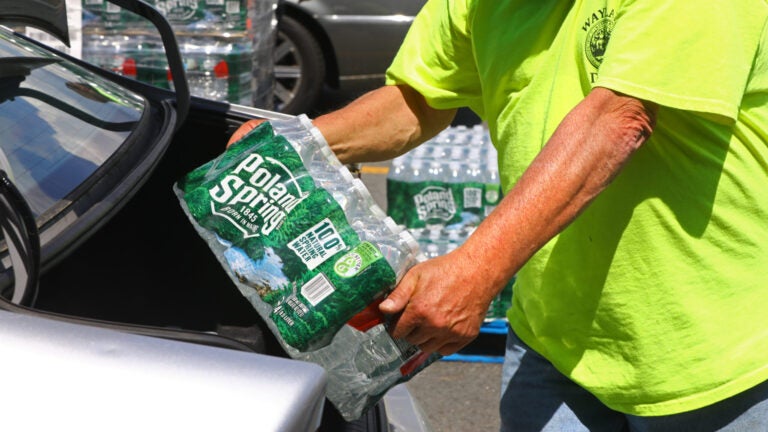Why do so many Mass. communities have contaminated drinking water?
“Certain PFAS chemicals can stay in our bodies for years.”

Since Massachusetts enacted new drinking water regulations last fall, some towns have found elevated levels of certain chemicals in their water sources.
In October 2020, Massachusetts began mandating water testing for levels of six PFAS chemicals, a class of chemicals widely used in the manufacturing of common products that are linked to negative health outcomes. Testing results recently became available from around half of the public water sources and, according to the Boston Globe, 20% of them found PFAS levels above the state’s limit.
Boston’s water is safe by these standards: The Massachusetts Water Resource Authority, which fully serves much of the Boston area, has not found elevated PFAS levels in the two reservoirs which supply to full-serve municipalities.
So, why test for these chemicals?
Polyfluoroalkyl substances, or PFAS, have been used since the 1950s to manufacture stain and water-resistant items. They’re used in things like nonstick pans, outdoor clothing, carpets, skis, and a particular type of firefighting foam used on oil or gasoline fires. Since PFAS are water soluble, they make it into soil and groundwater, and have been found in lakes, fish, and other wildlife.
PFAS travel widely. Dr. Laurel Schaider, senior scientist with the Silent Spring Institute, told Boston.com that PFAS have even been detected in polar bears up north.
“Certain PFAS chemicals can stay in our bodies for years,” she said “Certain chemicals have been phased out of production in the U.S. because of their ability to stay in our body and because of concerns about harmful health effects.”
Schaider noted that there are thousands of PFAS, but Massachusetts has chosen to test for these six chemicals because of the research linking them to health effects like certain types of cancer, elevated cholesterol, effects on the thyroid, and changes in the immune system.
“This has been on a lot of people’s minds lately with the pandemic – everyone is thinking about immune response, vaccinations, and antibody levels,” she said. “There have been a number of studies showing that exposures to PFAS can impair the immune system and affect the ability of the body to produce antibodies, which is part of our body’s normal response to vaccinations to protect our health.”
How it’s impacting local communities
Several towns — like Ayer, Holbrook, and Randolph – continue to deliver contaminated water while seeking solutions. When water testing showed that one of Wellesley’s three water treatment facilities had chemical levels above the state’s limit, the town shut it down.
Wellesley is partially served by the MWRA, so Public Works Director David Cohen said the town will be maxing out the amount of water they can use through that contract. The town has implemented a mandatory outdoor watering restriction, which assigns specific days residents can water outside, and asked people to reduce overall outdoor watering by 20%.
Since water rates are set based on the previous year’s usage, Cohen said Wellesley won’t know the exact financial impact until the next rates are set.
“We’ll be looking for all avenues [of support],” he said, “We’ve actually engaged a consultant to help us develop a treatment solution for the Morses Pond Treatment Plant, so they’re going to help us navigate the various sources that might be available… We absolutely will be looking for all of that…we expect there will be some assistance to help us come up with a solution and hopefully to implement the solution.”
Wayland was spending $20,000 a week to distribute bottles of water to 1,400 households, the Boston Globe reported. The town has also instituted an outdoor water use restriction, but a permanent solution will cost millions.
“To impose all of it on ratepayers at the local level seems unfair and really burdensome,” Town Administrator Louise Miller told the Globe. “I think both the federal and state government should look at spending more on specific water infrastructure. We’re talking about a lot of money.”
What can be done about it?
Schaider said the steps Massachusetts has taken are a great starting point, but there needs to be more broad work done to prevent these chemicals from getting into our environment in the first place. She referenced the essential uses framework, which would prioritize PFAS use where they’re necessary — in things like medical devices — and eliminate use in popcorn bags, fast food wrappers, and even firefighting foam.
“There are things all of us can do individually to reduce our reliance that will help reduce our family’s exposure, but really it’s a broader issue,” she said. “We shouldn’t have to be worried about toxic chemicals when we’re buying products for our families and I think the challenges with PFAS point to the shortcomings of how we regulate chemicals in this country. It really highlights how we can’t just stop using a chemical that we know is bad and pick some other chemical that we don’t know anything about and hope it’s better because what we’re learning is the newer substitute chemicals raise a lot of the same concerns as the chemicals they’re intended to replace.”
What’s the status of your town? Check MWRA results for the Boston area and find the state’s water testing results on the Boston Globe’s website.